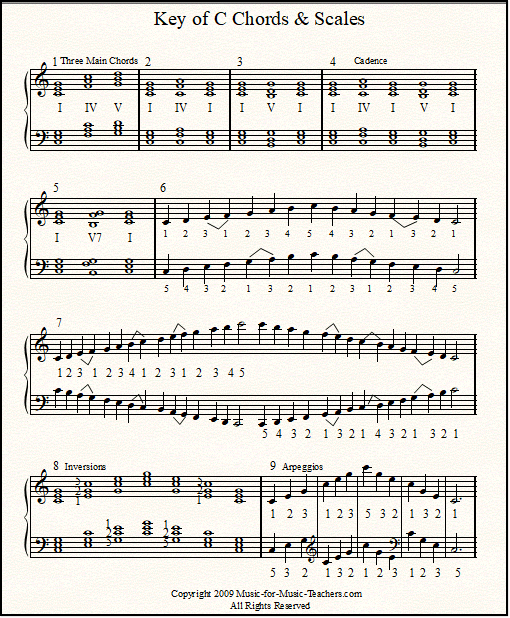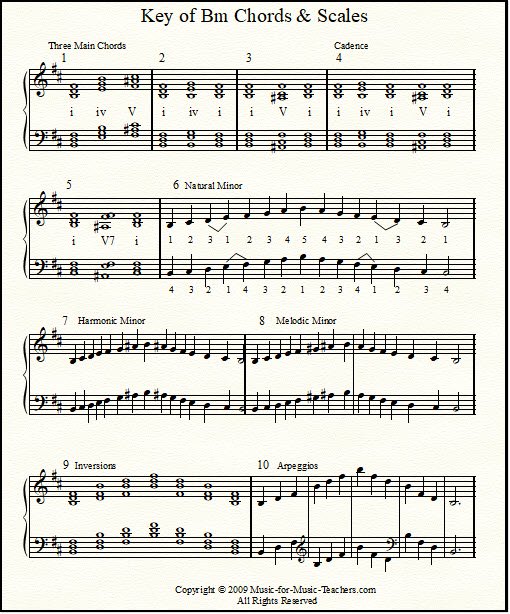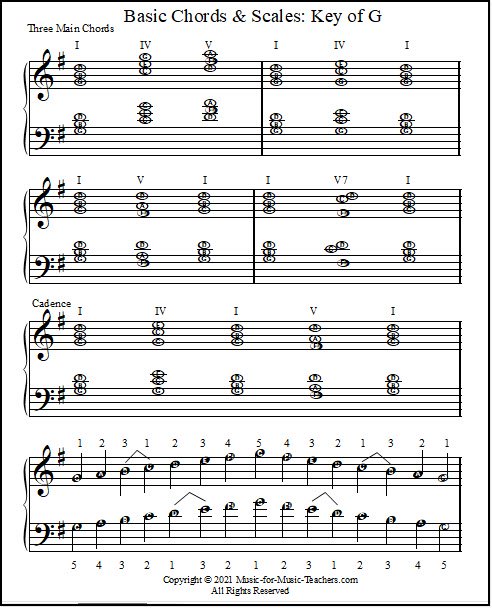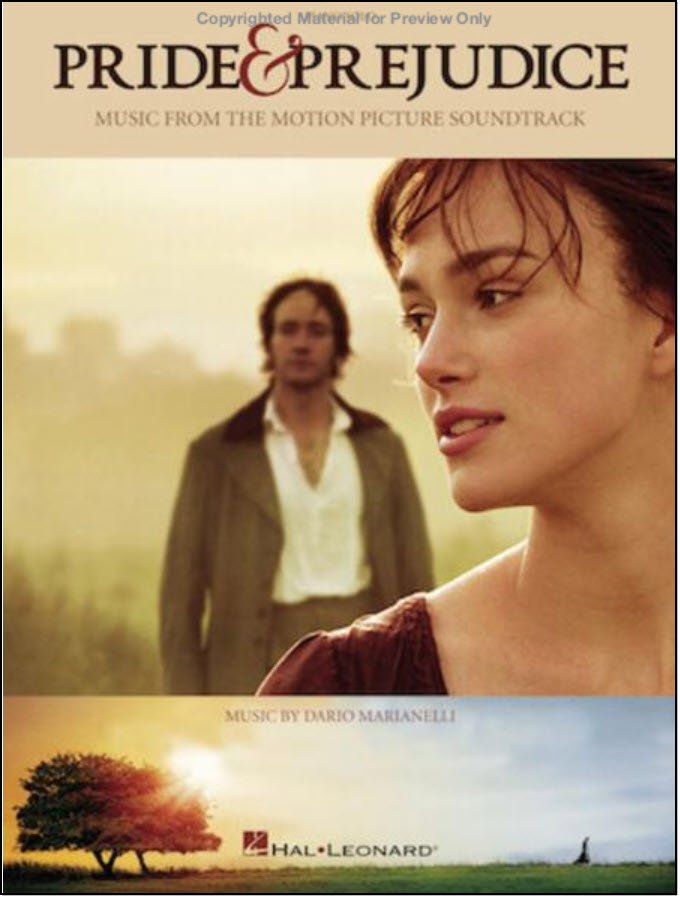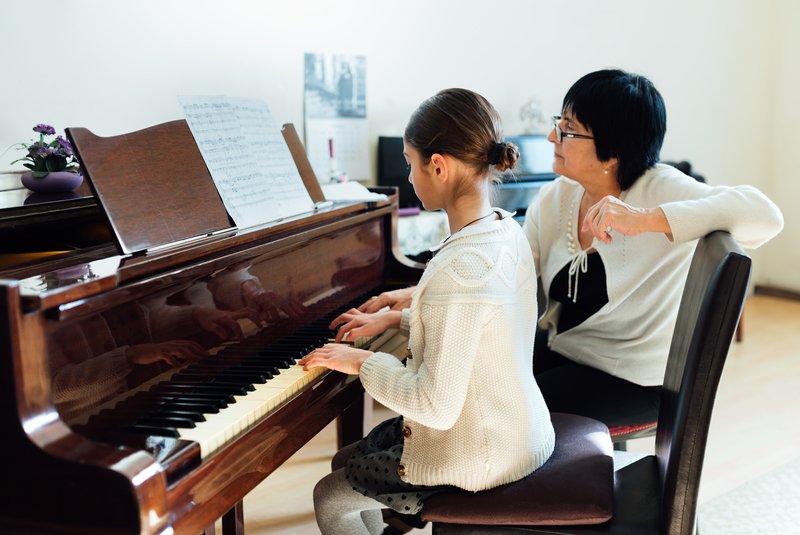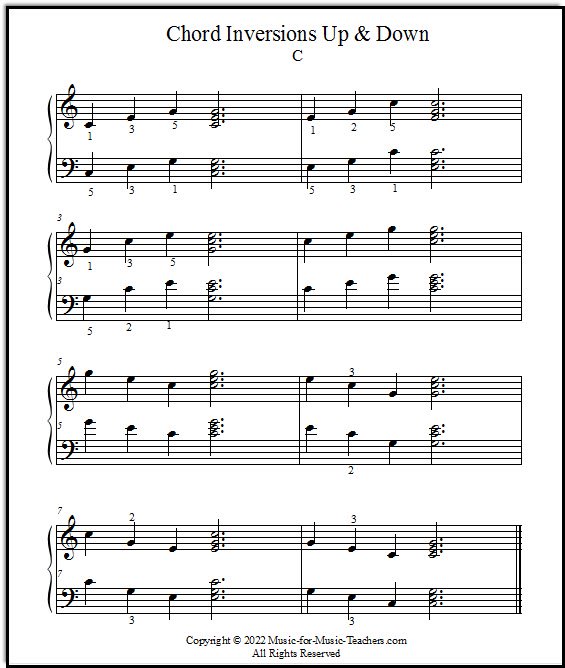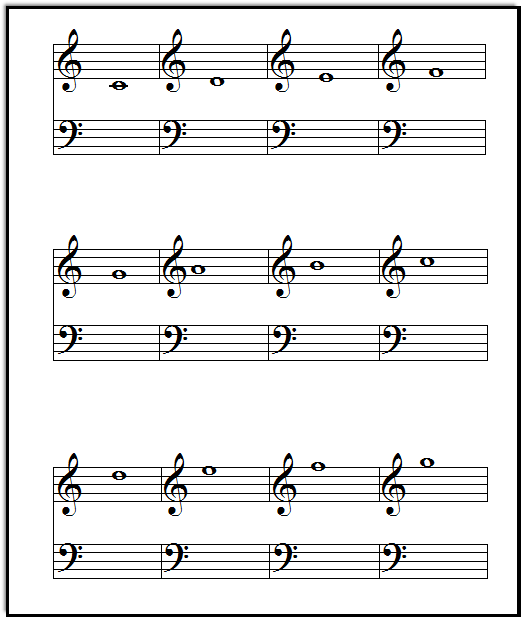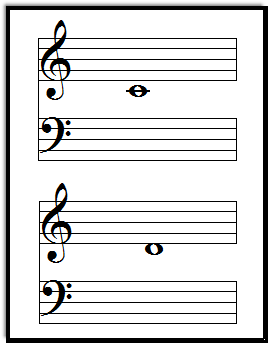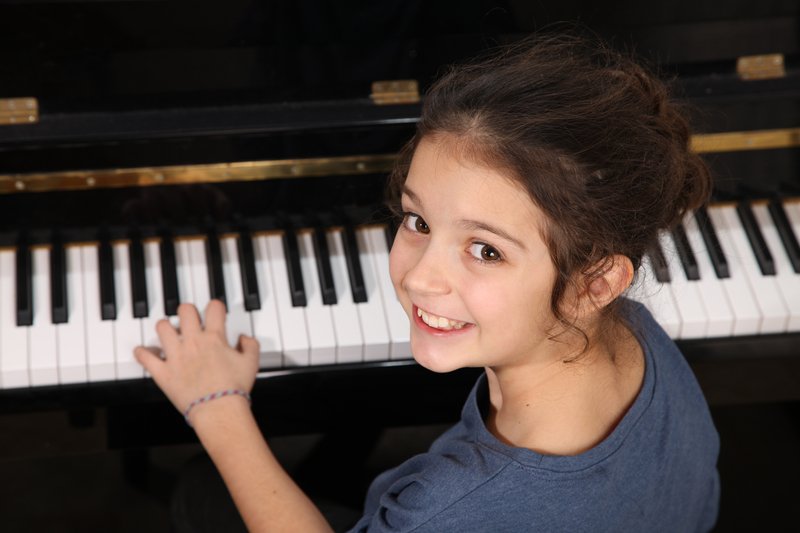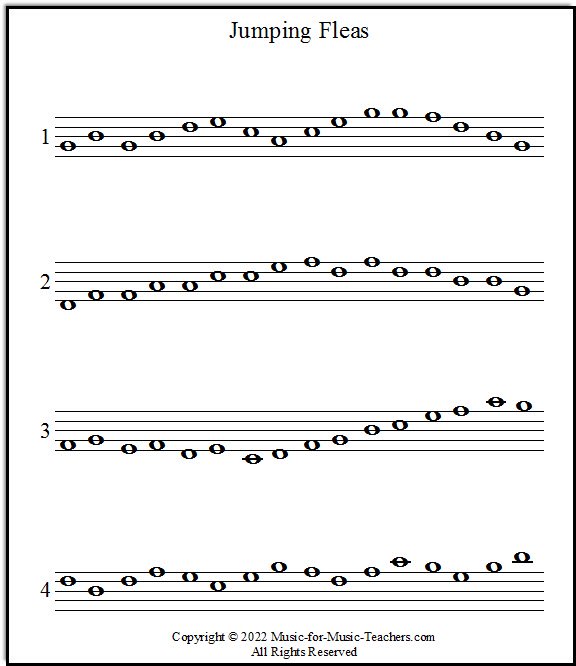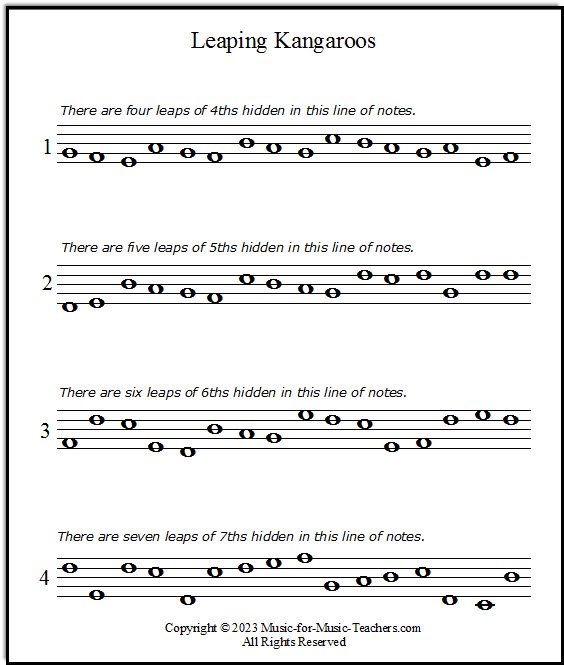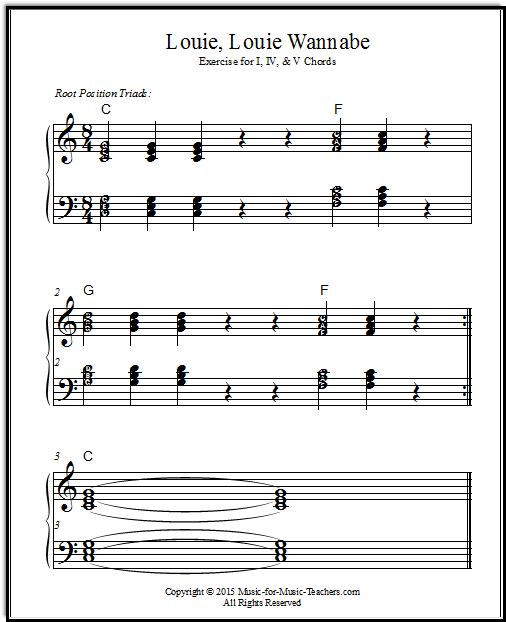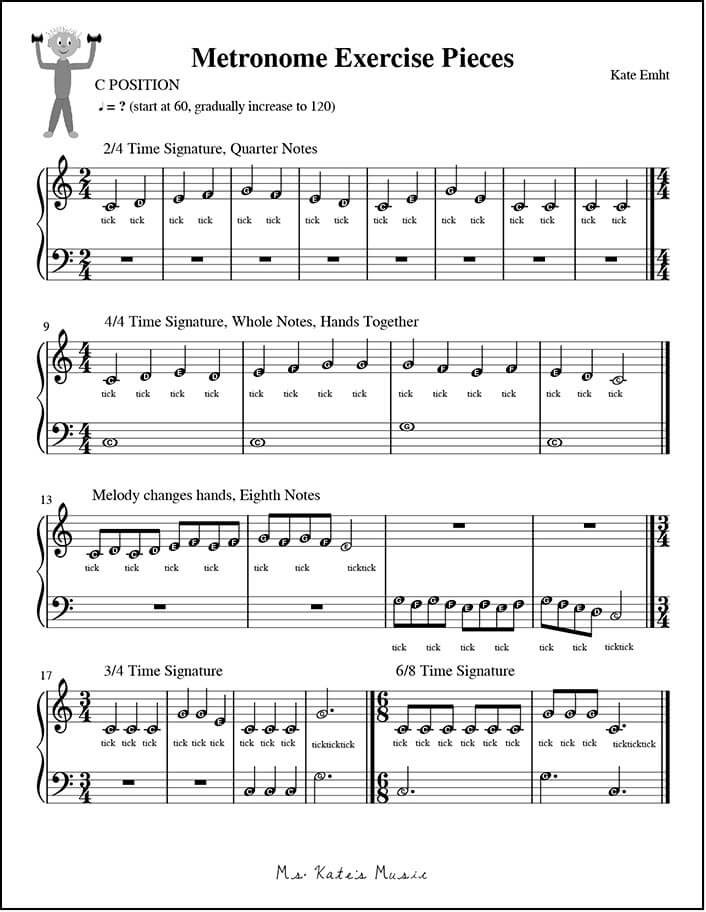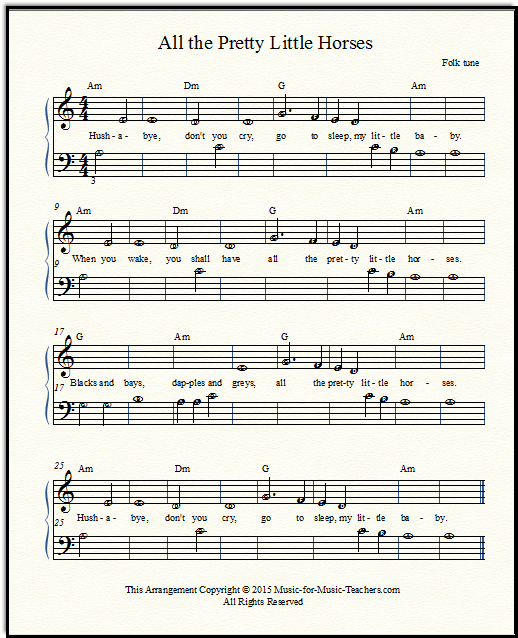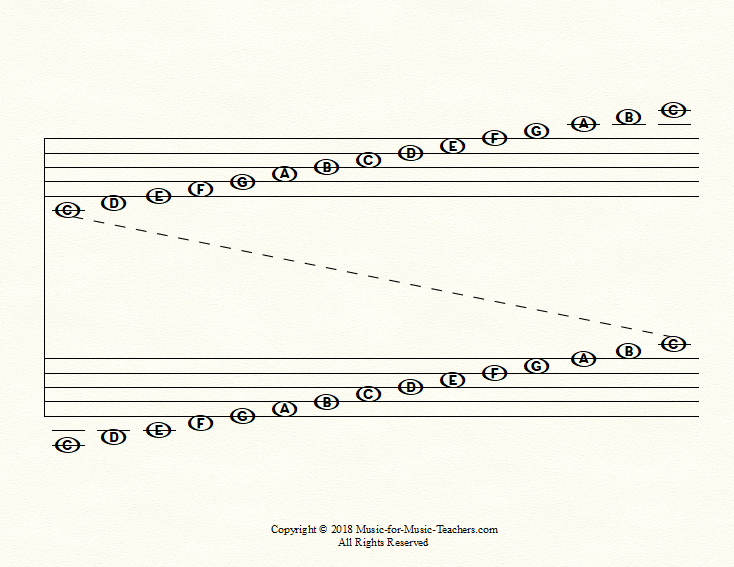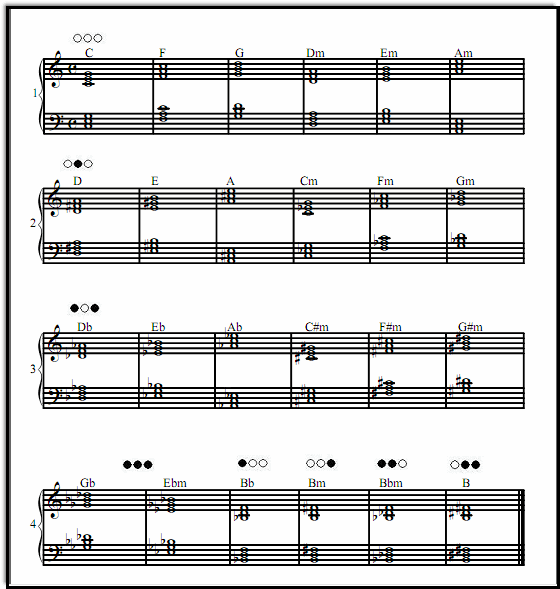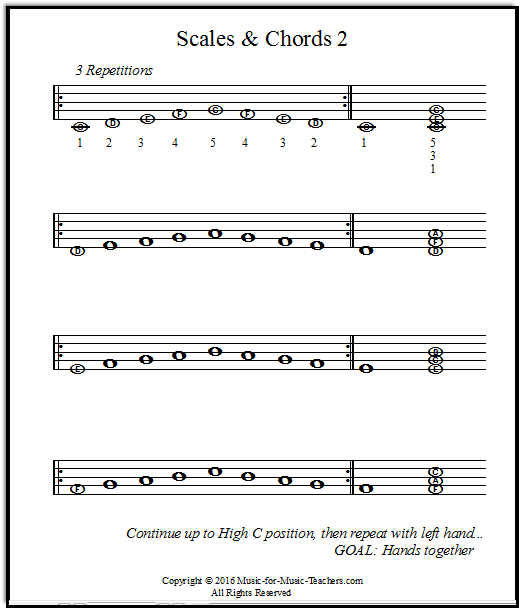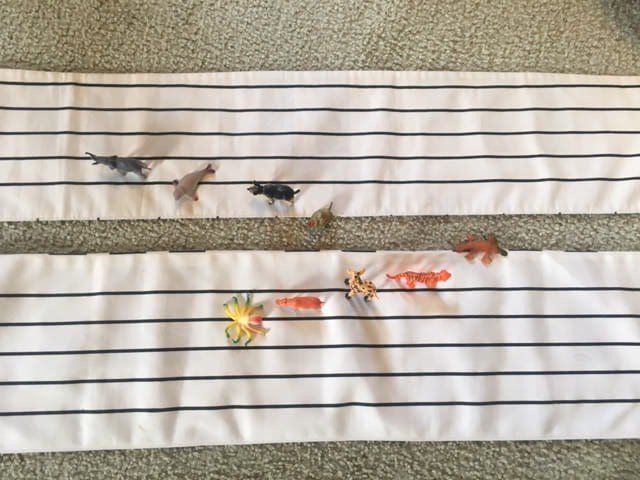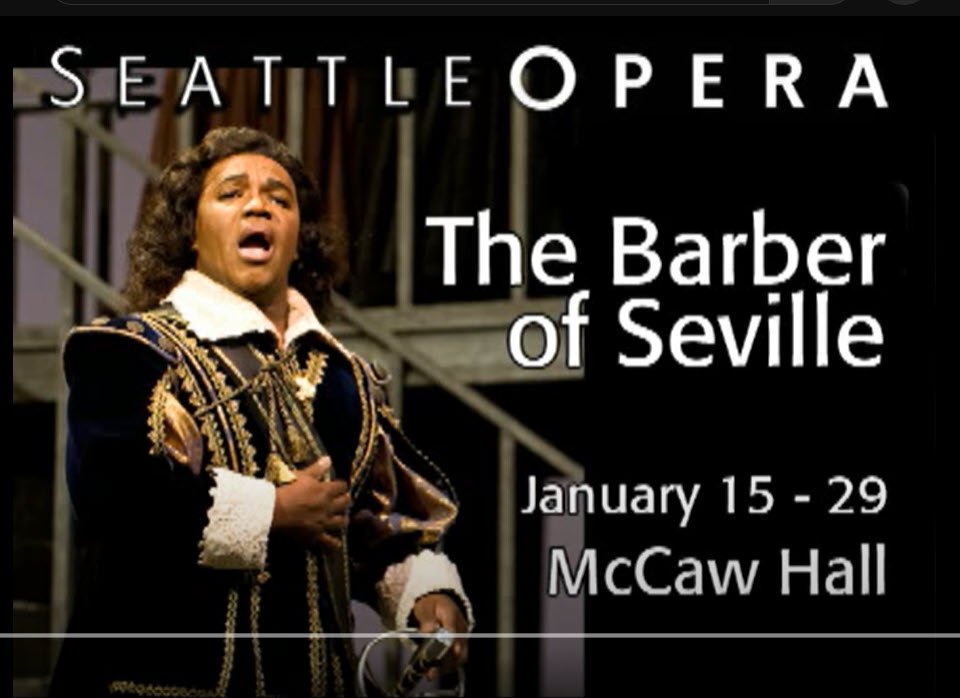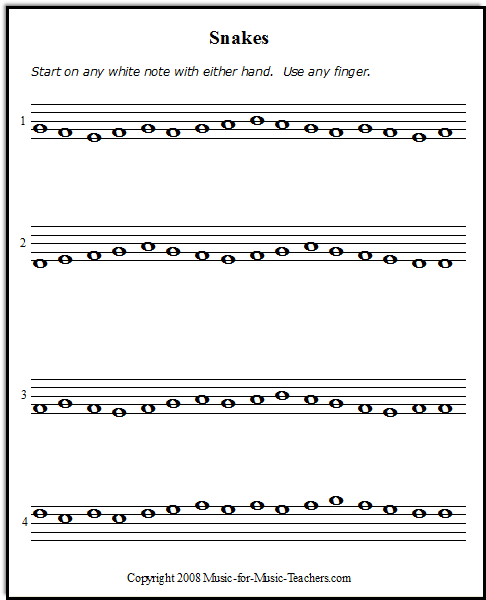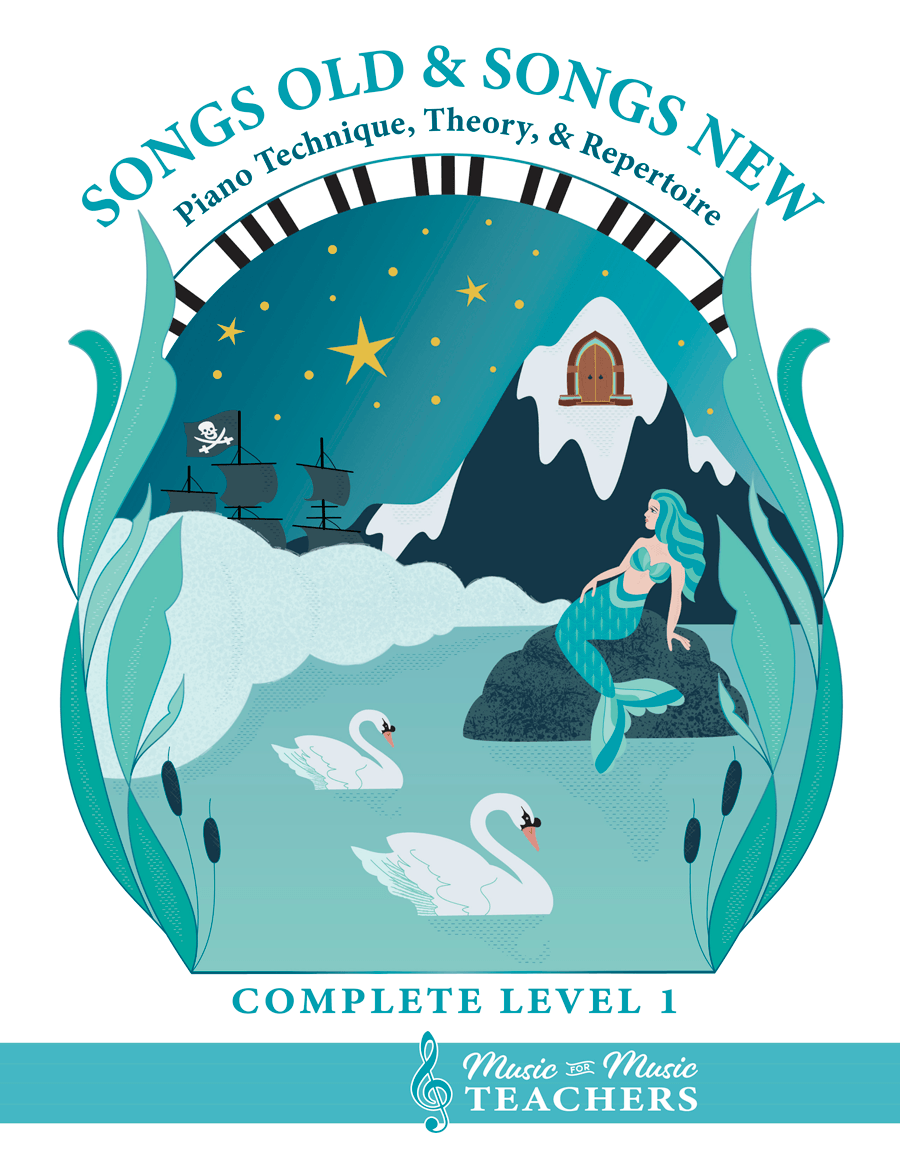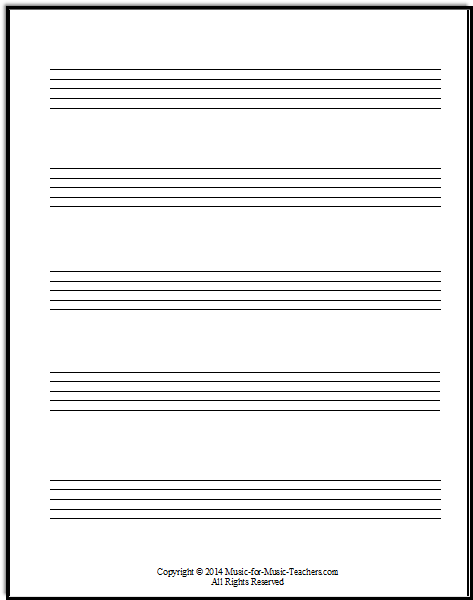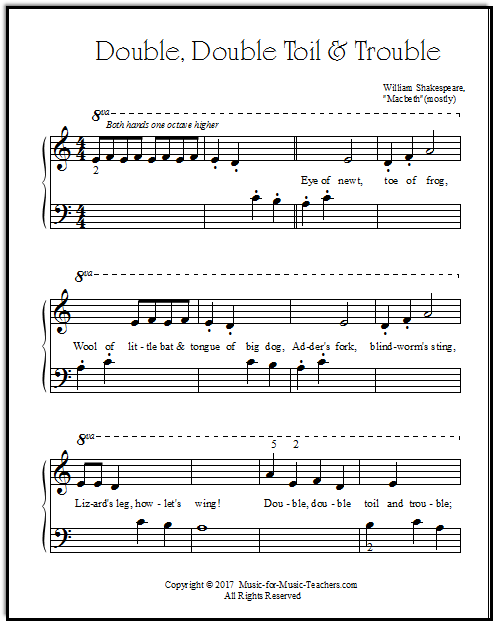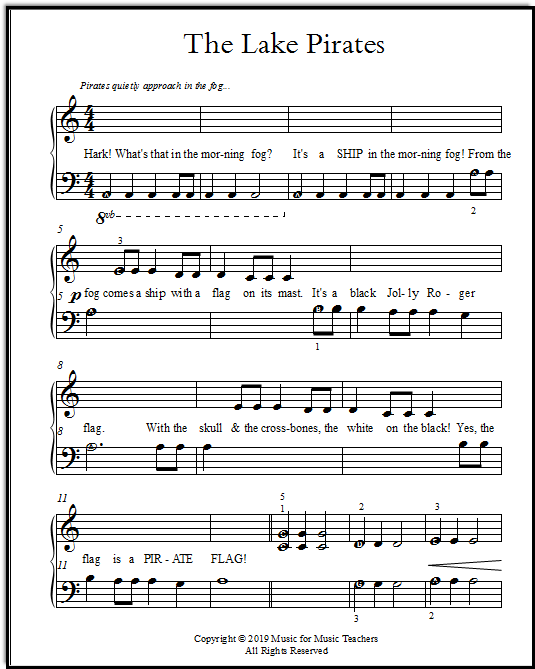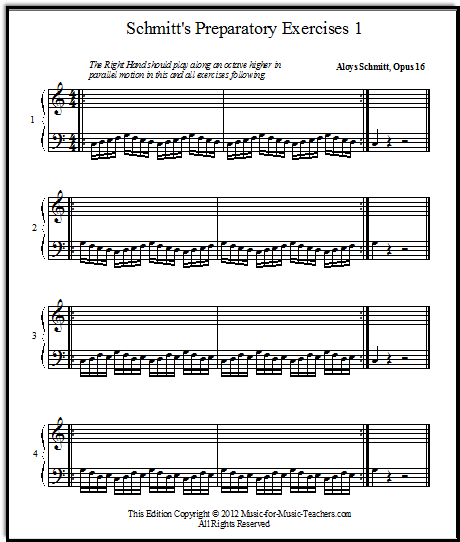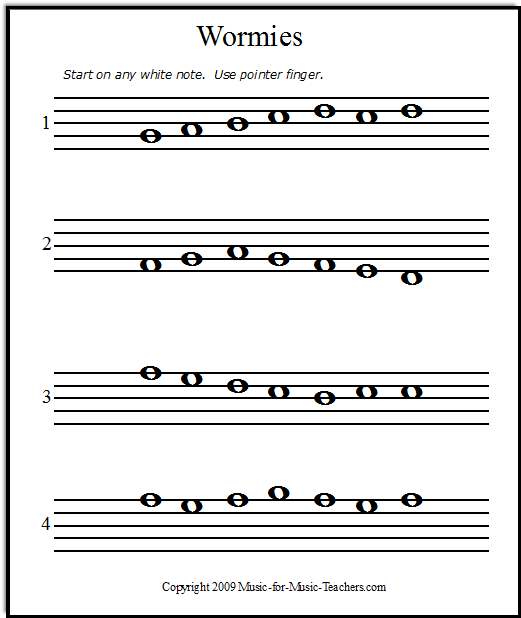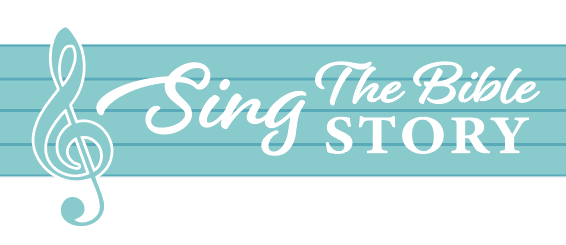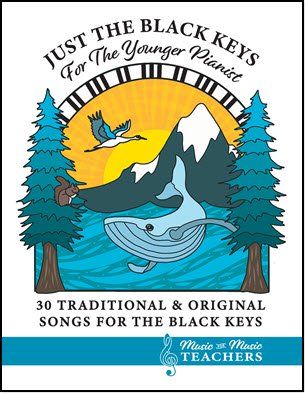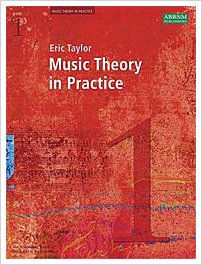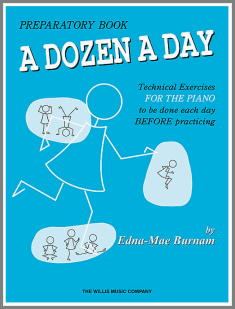12 Major Scales and Chords
12 major scales and chord groups for piano players: free, printable download.
- One-octave and two-octave scales,
- I, IV and V chords,
- tonic chord inversions
- and arpeggios, all on one sheet for each key!
Now with Part 2 for more advanced students...
Key of C, Part 2
Please scroll down the page for the download links.
Part 2 is still in process
I only have the Keys of C, F, G, and Bb finished for Part 2, but plan to get all the others up soon!
What do the arrows mean in #10?
Those arrows indicate to count UP by half-steps the number shown next to the arrow.
To make a Major chord: Start with any key (as shown here, "C," which is known as the "tonic" when in the key of C, hold that key, then count up 4 half-steps to find the next note of the chord, hold onto it, and then count up 3 more half-steps to find the next note in the C major chord.
Voila! That is the "secret formula" for making any and all major chords, starting on any key of the piano.
Many students are intrigued by this process... and it unlocks one of the beautiful mysteries of music!
My piano teacher wrote out all exercises by hand
As a child, I had no idea how much time the exercises must have taken for her to write -- for all of those keys, too! -- but even then, I appreciated and enjoyed playing these patterns.
There seemed something a bit magical and comforting in this routine: playing a pattern in one key, and then repeating it in another key, necessarily adjusting hand position and utilizing different fingering choices, getting the same overall sound, but with a sudden freshness.
My piano teacher wrote out all 12 major scales, chord progressions, cadences, chord inversions and arpeggios for me when I was a little girl. But she did it by hand! There were no copy machines, no computers, back then... how spoiled we've become.
Start with the easiest key
I always begin assigning the 12 major scales and chords with the "Key of C" sheet.
This won't be until my piano students are able to read the chord notes in the first measure (number 1) - or until they NEED to be able to play chord inversions and the octave scale, in which case I'll give them the Basic Chords & Scales sheet, with lettered notes.
We don't move in a hurry -- on their assignment sheet, I will write "Key of C sheet, #1," week after week, until they can do it quickly with no prompting.
Add new elements slowly
Soon, their assignment sheet will say,
"Key of C sheet, #2, #3, #4."
Eventually, they will drop the easiest numbers off their assignment and pick up the harder techniques, such as chord inversions and arpeggios:
Students tend to like diatonic scales
My students are always eager to start regular full-octave scales, perhaps because I don't introduce them early, but spend lots of time on pentatonic scales, and perhaps because they know REAL MUSICIANS practice scales.
You may wonder why I have written the 2-octave scales in mirror fashion, with the hands moving in contrary motion instead of parallel.
Well, using matching fingering "1-2-3, 1-2-3-4, (tuck under) 1-2-3 etc." is a very easy - AND FUN! - way to learn a hands-together C scale initially. (And the page didn't look as nice with crowded fingering when I initially laid it out with parallel scales!)
With the 1-octave scale, this is how I first approach hands together, so they can have the fun of achieving speed and coordination over the "big stretch" even in the initial stages of learning where to tuck under and cross over.
Of course, this becomes much harder in the later scales, when black notes enter the picture!
Students think the contrary-motion scales are fun, because the fingering is the same, and they can achieve speed and facility quickly. I think the contrary-motion scales are fun, too.
The three main chords
The concept of the I, IV and V chords seems obvious to piano teachers who've been thinking that way for years, but the connections aren't at all apparent to some young students.
I try to keep reinforcing their grasp of the theory of "chord families" by coming at it from different angles, such as playing "Louie Louie", but using major chords only (the real version has one minor chord)...
When they have memorized it, then we start it again in a different key! Same thing with Twinkle, Mary Had a Little Lamb, and others...
Show them what the numbers represent
One favorite way to talk about "The Three Main Chords" is to play the regular scale slowly with a left-hand finger, while making matching chords in the right hand.
Both hands move up the octave as I say, "The one chord, the two chord, three chord, four chord..." etc.
Then I ask them to do it. (And usually I say nothing about the chord on the seventh step of the scale and how it is different from all the rest; that would be too much information at this time!) The "Key of _________ Part 2" sheet will answer the mystery of what that penultimate chord is - a diminished chord.
Use a song they can relate to
And my favorite way to actually drum the 3 main chords into their fingers (and brains) is to use an energetic song.
Louie Louie Wannabe is my favorite. Louie Louie does make an impact, and stays with them, as long as I occasionally prompt them. I have to show them the video of the original song, and that context makes it even more fun.
Not an instant process
Students will move on to the other keys before they have finished the full page of C. Two-octave scales, chord inversions and arpeggios will wait until they seem appropriate.
Fingering is subjective
You may not agree with every one of my arpeggio or scale fingerings. I put down the ones I want my students to be familiar with first, what I consider "standard." When they apply scales and arpeggios in actual music, there will be exceptions to the rule!
Certainly there are times when it is advisable to choose "5, 4, 2, 1" for left-hand arpeggio fingering, but I consider it the exception to the rule.
Judith, in Canada, suggests starting with finger 2 when playing all-white note arpeggios in the right hand:
"Try starting all white note arpeggios with 2nd finger in the right hand instead of 1st finger; This eliminates reaching a 4th when turning 1st finger under and replaces it with a 3rd.
"I always allow my students to experiment to find which fingering fits their hand best.
"For me the basic rule of fingering is that it must be logical and the hand must move smoothly; as long as students follow that guideline, they can use any fingering they wish.
"Just a little note: B Major and B minor are awkward arpeggios, no matter which fingering is used."
Just cross my fingering out if you want something different.
I hope you find these 12 major scales and chords sheets useful in your music studio!
The links for the scale downloads, in alphabetical order:
Download free major scales and piano chords chart Key of Ab
Download free major scales and piano chords chart Key of A
Download major scales and piano chords chart Key of Bb
Download free major music scales and chords chart Key of B
Download free major music scales and chords chart Key of C:
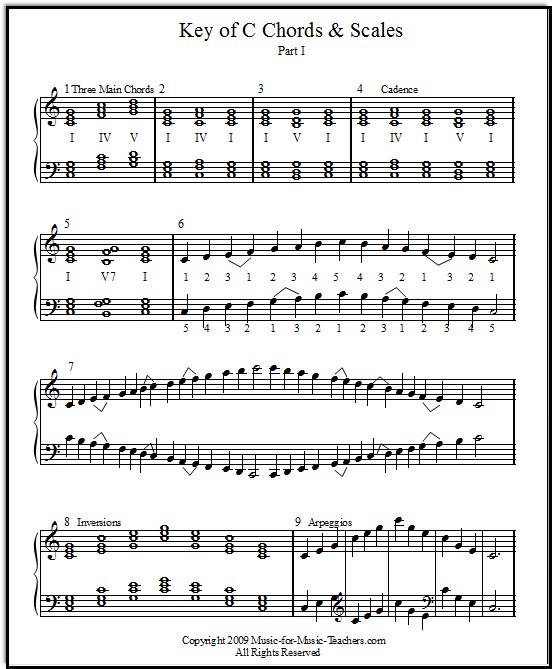
Part 2
THE KEY OF C PART 2 - this is a link
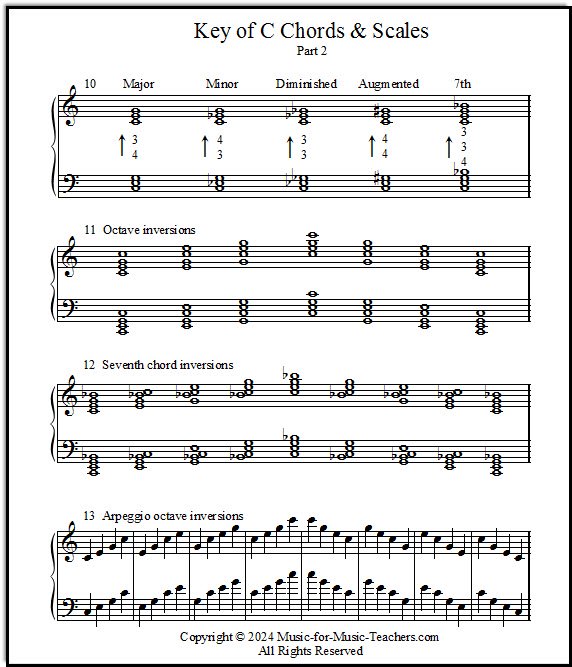
(A beginning version of the Key of C sheet, called "Basic Chords & Scales," with lettered notes, can be downloaded on this page...)
Download free major music scales and chords chart Key of Db
Download free major music scales and chords chart Key of D
Download free major music scales and chords chart Key of Eb
Download free major music scales and chords chart Key of E
Download free major music scales and chords chart Key of F
Download printable music scales and chords chart Key of Gb
Download printable major scales and chords chart Key of G
And here are the enharmonic keys:
Download enharmonic chart Key of C#
Download enharmonic chart Key of F#
Download enharmonic chart Key of Cb
Part 2 of the 12 Major Scales
More are coming... for now, there is Bb, C, F, & G (today is March 6, 2025)
Check out a fancy version of the Pachelbel Canon that even elementary students can play!
Music for Music Teachers has other great free resources for piano teachers! Take a look:
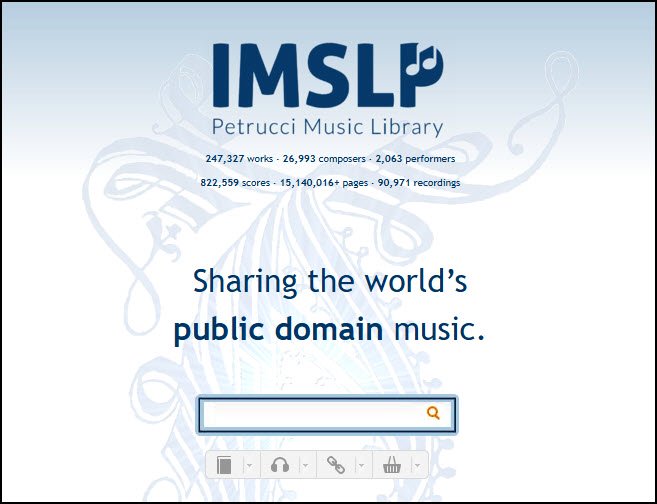
IMSLP -This link will take you off my site, to an international library of free classical sheet music.

Studio Favorite, currently! This changes from time to time.
"Passacaglia" is based on a piece by Handel, and it is NOT found on my website.
Dianna:
Your website is a light in the darkness. THANK YOU for all you do in helping to spread the love of music. It matters!
Recent Articles
-
Favorite Christmas Songs: Duet Vocal Sheet Music
The best duet Christmas songs are those ones you knew & loved as a child! This set of 14 "a capella" carols arranged for 2 voices is just right for caroling! -
"Walking In the Air" Piano Music from The Snowman
This sparkling piano arrangement of the main musical theme from The Snowman will win your students' hearts and imaginations, too, with its soaring beauty! -
Moonlight Sonata: How to Play Beethoven's Lovely Piece
Moonlight Sonata: How to play this beautiful but difficult piece full of black keys & triplets? With larger-than-usual notes, & letters inside the note heads! -
Classical Piano Sheet Music: a Set of Introductions
Classical piano sheet music - Fun, mostly one-page intros! Bach, Beethoven, Mozart & more - see what's new! -
Singing In a Round: "Come Away" Has Six Possible Parts!
Singing in a round is a fun challenge for voice students! This pretty song, "Come Away," can be sung with as few as 2 voices, or as many as 6. Free PDFs!!
Interested in songs from the Bible for your students or church? Check out my other website, SingTheBibleStory.com!
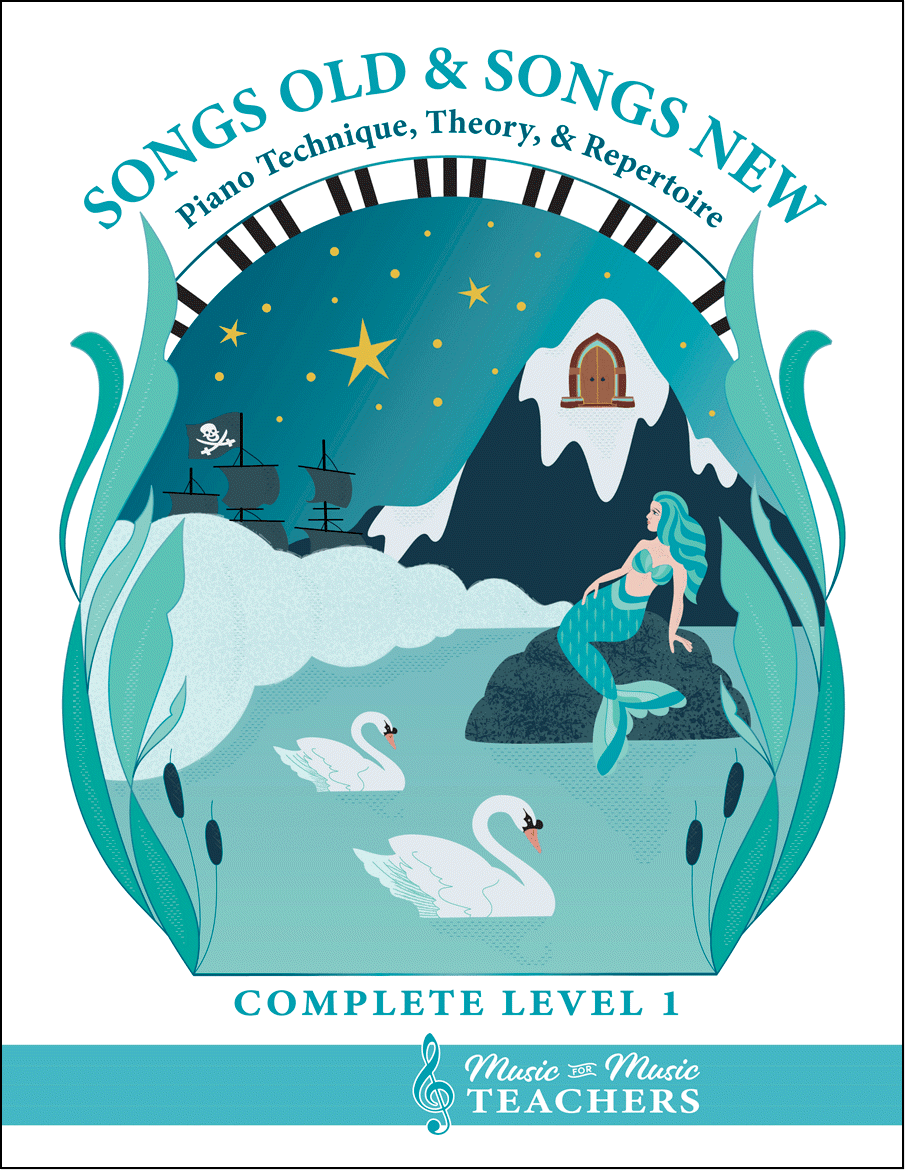
All the first-year material I give my beginner students.
Piano keyboard sheets, scales, chords, note-reading exercises, and over 256 pages of music!
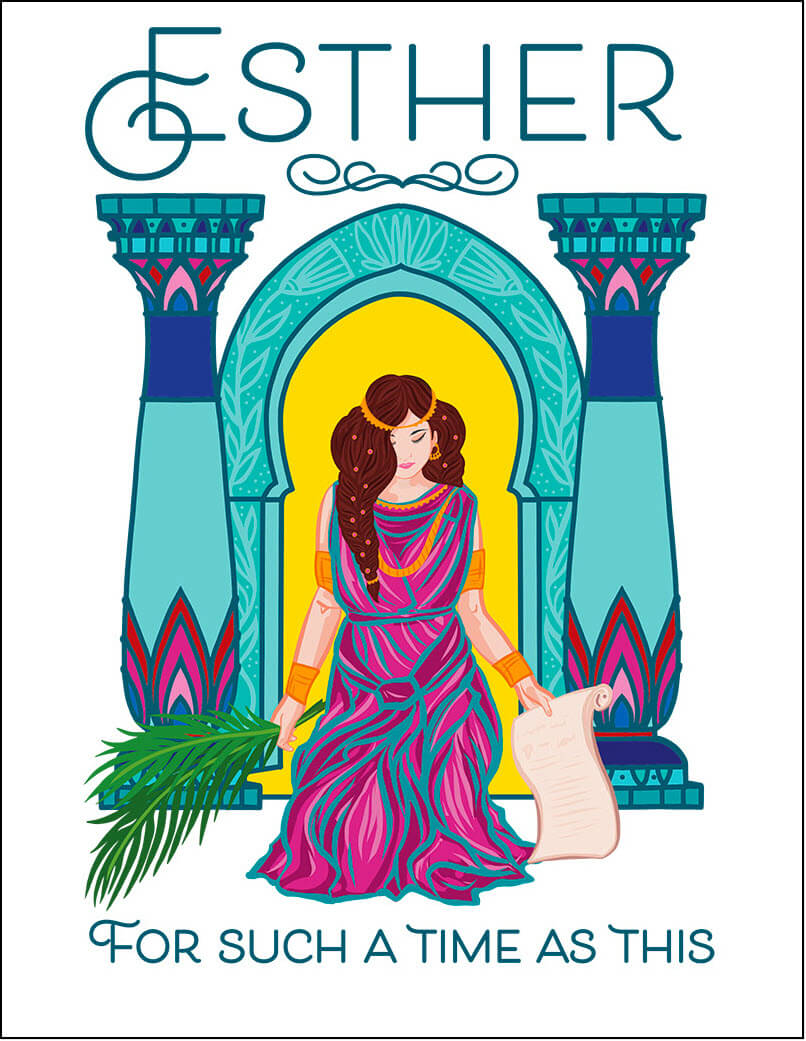
This beautiful song book for piano & voice "Esther, For Such a Time as This", available as a digital download, tells the riveting story of the time when Jews in ancient Persia faced a foe named Haman, and how a brave young queen risked her life to save her people.
A good choice for a singing story-teller, an operatic group, a short theater production, or a class of children!
This book is also available from Amazon as a paperback.
This book is available as a digital download from this site. Visit this page to see some free examples from the book.
It is also available from Amazon as a paperback!
This is the perfect easy start for little pianists.
And when they start reading white-key notes on the staff, this is a fun easy resource to say each week, "Choose a new black-key song at home this week and figure it out to show me next lesson!" They will be spending more time at the piano.
A perfect read aloud storybook
for little boys or girls.
The Adventures of Tonsta highlight the travels of a very young boy with a good heart, who goes about helping folk in trouble.
With a red cap on his head and a sack of tools slung over his shoulder, Tonsta seems to meet people in distress wherever he goes.
Lots of trolls in this book - including one who gives him a Christmas gift!
MusicGardenStudios:
This is an absolutely wonderful site!
As a voice and piano teacher looking for enrichment material for beginners, I have found your collections to be comprehensive and purposeful. It is clear that you are a wonderful musician and educator. Thank you!
Cat:
Thank you so much for these resources - I have a small music studio in Johannesburg, South Africa.
My kids love playing these tunes.
Comments: Do you have a story or a question about music teaching? Share it!
Please note that all comments are moderated, and will not appear until I have approved them. Also, IF YOU ARE ASKING FOR MUSIC THAT IS NOT IN THE PUBLIC DOMAIN, YOUR REQUEST WILL BE IGNORED. That's pretty much any music written in the last 75 years...
What Other Visitors Have Said
Click below to see contributions from other visitors to this page...
Major + Minor Scales 




This is a lot more user friendly to print out.
Printable major & minor scales
Dana:
Hi, Chris,
You're comparing apples & oranges. It is …
Dominant Seventh Chords and Inversions 




I was very pleased to find your chords and scales some time ago, and have been using them with my piano students. I am wondering if you have dominant …
Thank You Not rated yet
These fundamentals are crucial to my success as a pianist. Thank you for posting this resource!
Combing the Internet for Resources Not rated yet
I am a first-time piano teacher and have been combing the internet for resources. Your wonderful site has been an amazing resource for both my students …
Pray Sing Hymn Not rated yet
Thank you soooooooo much!! This is a wonderful website! I was looking for the perfect kind of scales for my students! It was exactly what I was looking …
THANKS!!!! Not rated yet
I'm a teacher but I was not taught these scales and I had to watch another person play, and when I saw your pdfs, they're really useful to me, everything …
Minor Scales & Cadences Not rated yet
Hello,
Do you have the minor scales & cadences written in the same format as the major scales and available for download? Thank you!!
Alice Donovan …
About the Author

Hi, I'm Dana! (Say that like "Anna".) I'm the owner of Music-for-Music-Teachers.com, and a newer site, SingTheBibleStory.com.
Like some of you, I've been playing the piano since early childhood, and have added a few other instruments along the way, plus an interest in arranging and composing music.
You can find out more about me and the reason for this website at my About Me page.


